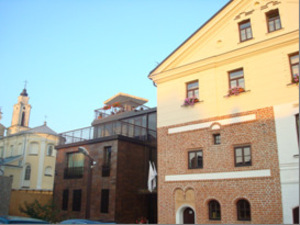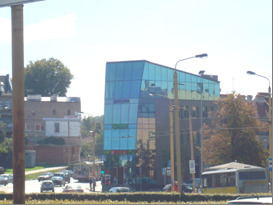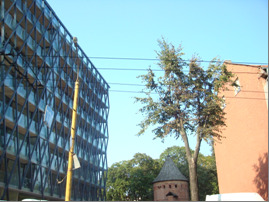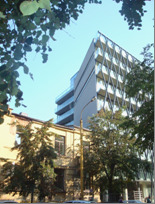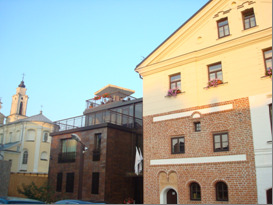DIALOGUES OF OLD AND NEW ARCHITECTURE IN KAUNAS OF THE 21ST CENTURY 0
Evelina Karalevičienė
www.kamane.lt, 2007 09 14
Hotel Kaunas: harmony of old and new architecture
New commercial-administrative building has been integrated in the premises of the Old Town well
The appearance of Akropolis has changed the panorama of the city markedly and received much criticism due to this
The emergence of a high-rise building in this place is the most painful confrontation of contemporary architecture with the historical environment
The prime recent combination of old and new architecture in the Old Town. Photos by Evelina Karalevičienė.
In brief: Even a bat-eyed person will notice that Kaunas has changed remarkably during the last decade – old buildings are being restored, renovated and adapted to the present-day needs, new buildings of contemporary architecture are arising nearby. The face of Kaunas getting modern receives much criticism of specialists, especially regarding the intrusion of new architecture into the New Town and Old Town.
However, the city is not a museum, it should be convenient for living first of all. Who will deny the convenience of Akropolis shopping centre? A city inside the city – everything is in once place. The 21st century is the century of consumers. Or who would not be willing to live on the upper floor of the multi-storeyed building on the corner of I.Kantas and Kęstutis streets in Kaunas from which picturesque panoramas of the city may be seen.
Still, not everything is so simple. We have inherited Kaunas with a certain character, architectural values which we should preserve. The confrontation of the old and the new is not always painful. Thinking about the changing Kaunas of the 21st century, the author reviews the more outstanding cases of confrontation of old and new architecture during the last decade and tries to evaluate their impact on the urbane face of the city.
The building in the central part of Laisvės Alley in which the hotel Kaunas is established was renovated in several stages. The old architectural frame was preserved and new architectural forms were added – an attic of moderate volume and wavy silhouette has been designed in order to expand the space. The new parts of the building do not have any major impact on the main body – its architecture is independent and tectonic, observes the author.
Another example of successful integration into the united urbane environment is the administrative and commercial building in Jonavos Str. 16, which is known to the majority of Kaunas residents. The architects Rimvydas Palys, Žilvinas Radvilavičius and constructors succeeded to make the object bright, it seems to mark the premises of the Old Town. The building gave sense to the aesthetics of contemporary materials and forms and became a positive sign of recognition for the future. Even though it looks like a block from a mountain, it does not breathe any coldness and insensibility to the old architecture.
The emergence of the new shopping centre Akropolis in the New Town, Karaliaus Mindaugo Avenue caused many discussions. The giant building covers three quarters and is connected with the over-ground automobile parking lot. It has changed the panorama of Kaunas completely. Still, according to the author, the shopping centre has several advantages: the forlorn territory was tidied up. The well-lit garages give prominence to the night silhouette of the New Town at night. The biggest value is the successful integration of the old factory buildings into the new complex.
The most painful example is the construction of the high-rise building on the corner of I.Kantas and Kęstutis streets meanwhile. Two facades of the glass building seem to be covered by a huge sock of iron net while the third mirror façade is directed at Millers’ Towner nearby. The environment is too tight for such a building; therefore, it is hardly justifiable in the New Town. The creative language of the architect Gintautas Natkevičius surpasses time and receives compliments of specialists in many cases. Still, the latter example of his work may not be praised by specialists for the neglected scale of the quarter and its premises. The building became an opposite to Kaunas Central Post Office, Musical Theatre and other objects.
Another change occurred in one of the most forlorn zone of the Old Town – in T. Daugirdo street where the hotel Daugirdas is established. The historical building of the 16th-19th century restored according to the architect Asta Prikockienė’s project exposes the layers of all centuries and is connected with a new building. It may be called the prime connection of old and new architecture in the Old Town. Still, the author of the article notes that harmony between different periods of architecture was not created in all places. Sometimes the integration of the old and the new is too harsh. Even though the new wing complies with the scale of the environment, it seems to be dead. Meanwhile, the internal yard covered by a roof mitigates the strictness of the junction of the new and the old parts of the building. It reflects the dialogue among centuries the best.
Only several architectural dialogues, which form the face of old Kaunas stepping into the 21st century, are studied in the article. There are several times more successful and problematic examples. Summarizing the general view, the author concludes that historical Kaunas will not be killed by new architecture for sure. Nonetheless, it is important that the city would stay optimistic and that heritage protectors and architects would strengthen their cooperation, tolerance and mutual respect.
